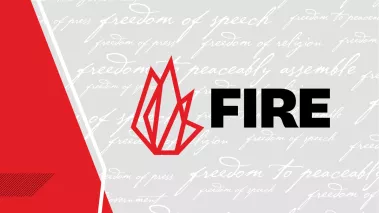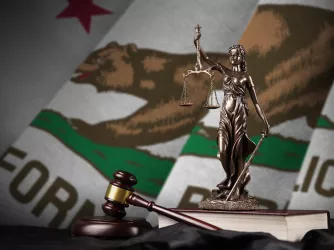Table of Contents
Threats, Intimidation, and Free Speech

One of the compelling storylines to take away from this year involves a matter that is still fresh in many people’s minds and remains troubling to this day: the Virginia Tech shootings. The horrific events of that day may understandably send a chill down the spine of anyone who has a friend, significant other, child, or family member attending school or working on a college campus. In the wake of Virginia Tech, universities across the country have tried to take the necessary measures to ensure, to the greatest extent possible, that they can prevent a similar tragedy from taking place again.
These reactions are perfectly natural and indeed laudable, since one of the chief concerns of any university administration is maintaining a safe and secure campus. However, FIRE has seen a disturbing trend this year toward applying what should be narrow prohibitions against threats and intimidation in a way that censors clearly protected speech. This is an important issue to watch for in the new year and beyond.
At Hamline University, for example, student Troy Scheffler was placed on immediate suspension in April for sending emails that the administration deemed “threatening.” In replying to an email sent by the Vice President of Student Affairs (VPSA) offering Hamline students extra counseling in the aftermath of the Virginia Tech shootings, Scheffler opined that Virginia Tech’s ban on concealed weapons had contributed to the massacre and argued that Hamline should eliminate its similar policy. That was as “threatening” as he got in his email, which, importantly, was sent only to the VPSA and not to the entire university community. Two days later, when Hamline’s president sent out another email about Virginia Tech, Scheffler replied again, reiterating his previous arguments. Once again, his response was sent directly to the sender of the initial email.
On the basis of these two emails, Hamline somehow decided that Scheffler posed a threat to the campus community. It did not afford him any type of hearing, instead notifying him of the finding in a summary letter. Moreover, not only did it place him on immediate suspension, it stipulated that he could not return to school unless he submitted to a “mental health evaluation.” While the case remains unresolved, one marvels at how far Scheffler’s conduct falls from constituting a “true threat” as defined by the Supreme Court. In Virginia v. Black, 538 U.S. 343, 359 (2003), the Court said that true threats are made up of only “those statements where the speaker means to communicate a serious expression of an intent to commit an act of unlawful violence to a particular individual or group of individuals.” Scheffler did not threaten to commit any type of violence, nor did he target a particular individual or group. Therefore, it remains mystifying that anyone could construe his message as communicating a true threat.
And yet Scheffler’s case might not be the most egregious one from this year. At Valdosta State University (VSU), student T. Hayden Barnes was labeled a “clear and present danger” by the school administration in May for doing nothing more than protesting the school’s decision to build two new parking structures on campus. Concerned about the costs of construction (to be paid out of mandatory student fees) and the potential for increased pollution, Barnes created a collage of pictures on the website Facebook.com. The collage included various images and captions relating to Barnes’ environmental concerns and made reference to a Zaccari Memorial Parking Garage, satirizing VSU President Ronald Zaccari’s publicly stated concerns about his legacy.
Amazingly, this was enough for President Zaccari to determine that Barnes constituted a threat specifically to Zaccari and more generally to the entire campus. Barnes was given a notice of “administrative withdrawal” and required to submit certifications of his mental health and ongoing therapy in order to be readmitted. Once again, this is a case of student speech being suppressed because of disagreement with its content, under the pretext of punishing and preventing threats and verbal intimidation. And as was the case at Hamline, the university imposed a significant punishment, one that is very damaging to the student’s academic career, and did so without allowing for the most basic of due process rights.
In stark contrast to these and similar cases, perhaps nothing better represents the proper approach to intimidation and threats than the recent ruling in the San Francisco State University case. In striking down parts of the California State University system’s speech code, U.S. Magistrate Judge Wayne Brazil declined to enjoin the enforcement of another provision prohibiting “[c]onduct that threatens or endangers the health or safety of any person within or related to the University community, including physical abuse, threats, intimidation, harassment, or sexual misconduct.”
Even though Judge Brazil ruled against the plaintiffs in this aspect of the case, he did so under the understanding that “the structure of the challenged provision, viewed as a whole, suggests that it was not intended to proscribe ‘intimidation’ or ‘harassment’ in whatever form ‘intimidation’ or ‘harassment’ might take, but only the sub-category of intimidation or harassment that ‘threatens or endangers the health or safety of any person.’”
In other words, the provision would not be applied to a student who merely engages in expressive behavior with no intent to threaten or endanger the health or safety of another person.
Judge Brazil’s decision represents the proper balance between the two interests at stake: the preservation of free speech rights on a college campus and the prevention and punishment of true threats and intimidation. His opinion would therefore seem to be required reading for university administrators across the nation. Its clarity and principled adherence to the right to free expression should serve as a model approach for universities to emulate. Whether this comes to fruition is something that FIRE will follow with much interest in the new year.
Recent Articles
FIRE’s award-winning Newsdesk covers the free speech news you need to stay informed.

O holy fight: New Hampshire Satanic Temple statue threatened by more than vandals

California and other states are rushing to regulate AI. This is what they’re missing

One day after FIRE lawsuit, Congress passes changes to filming permits in national parks
